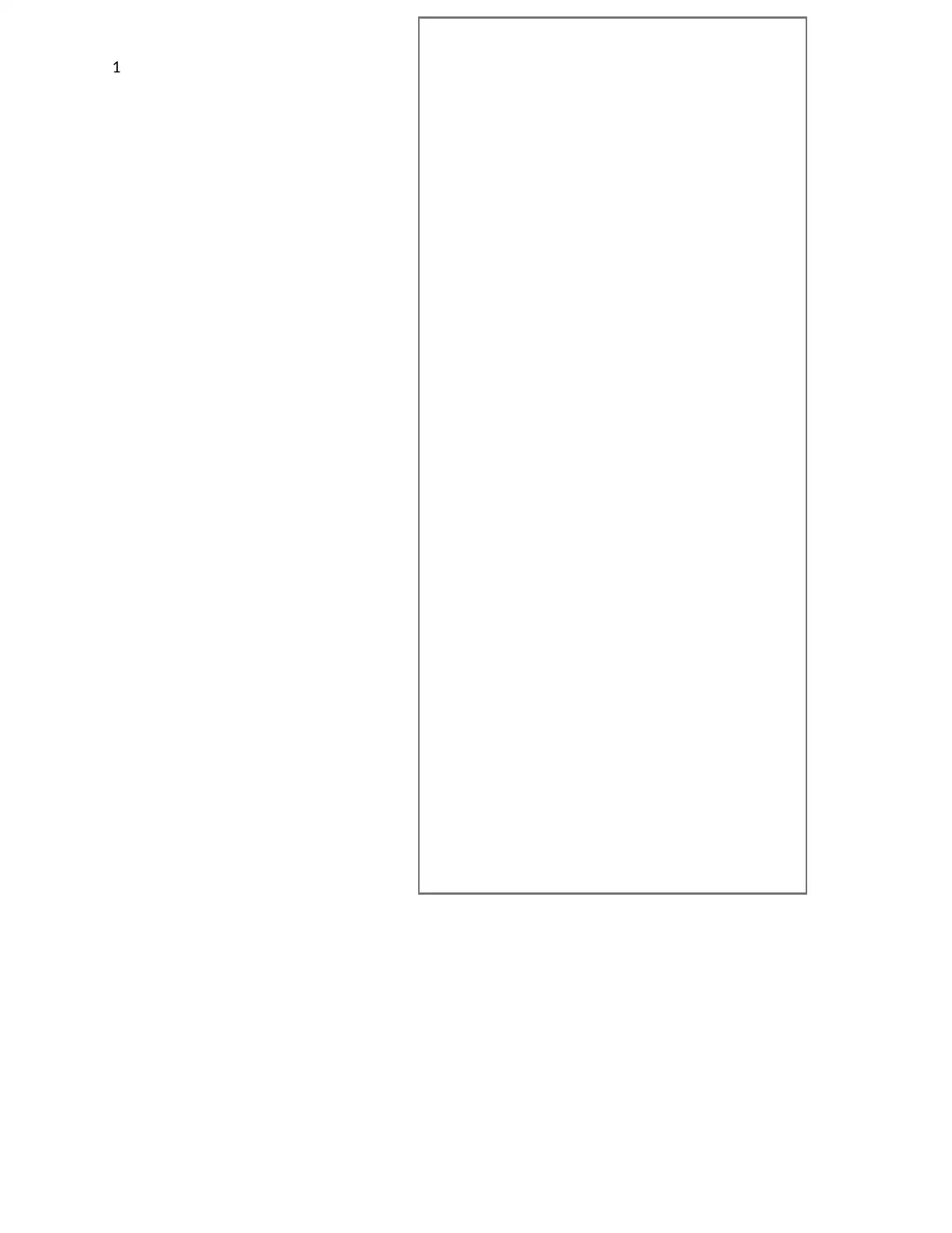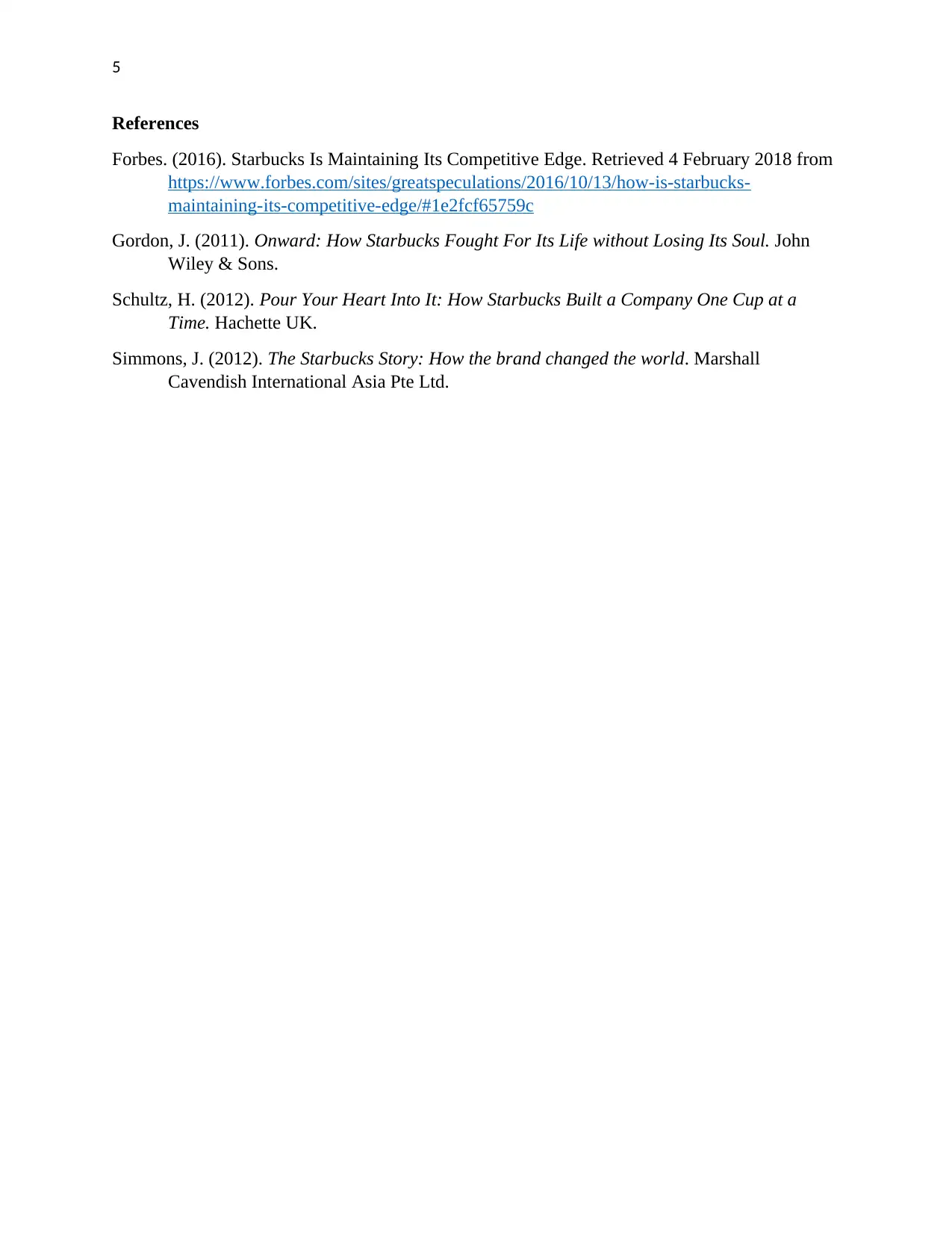Starbucks Case Study: Industry Analysis, Strategy, and Success Factors
VerifiedAdded on 2023/06/15
|6
|1012
|316
Case Study
AI Summary
This case study analyzes Starbucks' competitive position in the specialty coffee industry using Porter's Five Forces and macroenvironmental analysis, identifying key success factors such as strong brand image, financial performance, and strategic expansion. The analysis reveals Starbucks' strengths, weaknesses, and sources of sustainable competitive advantage, highlighting its early adoption of innovative products, capitalization on changing consumer behavior, and expansion into new markets. Starbucks pursues a broad differentiation strategy supported by functional-level strategies like sustainable sourcing, market penetration, and product development, which contribute to its unique position in the market. This document is helpful for students looking for similar solved assignments and past papers and is available on Desklib.

System04002
Paraphrase This Document
Need a fresh take? Get an instant paraphrase of this document with our AI Paraphraser

1

2
Analyze the specialty coffee café industry by using Porter’s Five Forces and
Macroenvironmental analysis. Given this, what are the key success factors in this
industry?
Porter’s five Forces Analysis of Starbucks
Starbucks is a specialty coffee industry, which is influenced by the five forces in the industry.
These forces are competitive rivalry, bargaining power of suppliers, threat of substitutes,
bargaining power of buyers, and threat of new entrants.
Competitive Rivalry
The company faces strong competition from other coffee companies, such as McDonald’s, and
Cost coffee.
Bargaining power of the Customers
There are several factors such as the low switching cost, the small size of the individual buyers,
and substitute availability which facilitates the customers in easily switching from the company
to other brands. Other than that, there are also several other substitutes, such as cold drinks and
instant beverages.
Bargaining Power of Starbuck’s Coffee’s Suppliers
There are several factors, such as high variety of suppliers, moderate size of individual suppliers,
and large supply. It can be stated that the suppliers have a minimal impact on the Company.
There are a large number of suppliers of the organization, which reduces the company’s
dependency on a single supplier (Schultz, 2012). The company has made a policy to diversify its
supply chain, and the size of each supplier is very less in comparison to the organization.
Threat of Substitution
The major contributors of this force is the availability of thee substitutes, low switching cost, and
low cost of the substitutes. It can be critiqued that the availability of all these factors is high and
the customers can easily shift to substitutes, such as beverages from the restaurants, and bottled
drinks. The cost of shifting to other products is also low; therefore, the threat of substitution is
very high.
Threat of New Entrants
Starbucks faces moderate force of the threat of the new entrants. There are potential factors, such
as the moderate cost of doing business, moderate supply chain cost, and high cost of brand
development. Therefore, there are not major barriers to the new market entrants.
Macroenvironmental Analysis
Analyze the specialty coffee café industry by using Porter’s Five Forces and
Macroenvironmental analysis. Given this, what are the key success factors in this
industry?
Porter’s five Forces Analysis of Starbucks
Starbucks is a specialty coffee industry, which is influenced by the five forces in the industry.
These forces are competitive rivalry, bargaining power of suppliers, threat of substitutes,
bargaining power of buyers, and threat of new entrants.
Competitive Rivalry
The company faces strong competition from other coffee companies, such as McDonald’s, and
Cost coffee.
Bargaining power of the Customers
There are several factors such as the low switching cost, the small size of the individual buyers,
and substitute availability which facilitates the customers in easily switching from the company
to other brands. Other than that, there are also several other substitutes, such as cold drinks and
instant beverages.
Bargaining Power of Starbuck’s Coffee’s Suppliers
There are several factors, such as high variety of suppliers, moderate size of individual suppliers,
and large supply. It can be stated that the suppliers have a minimal impact on the Company.
There are a large number of suppliers of the organization, which reduces the company’s
dependency on a single supplier (Schultz, 2012). The company has made a policy to diversify its
supply chain, and the size of each supplier is very less in comparison to the organization.
Threat of Substitution
The major contributors of this force is the availability of thee substitutes, low switching cost, and
low cost of the substitutes. It can be critiqued that the availability of all these factors is high and
the customers can easily shift to substitutes, such as beverages from the restaurants, and bottled
drinks. The cost of shifting to other products is also low; therefore, the threat of substitution is
very high.
Threat of New Entrants
Starbucks faces moderate force of the threat of the new entrants. There are potential factors, such
as the moderate cost of doing business, moderate supply chain cost, and high cost of brand
development. Therefore, there are not major barriers to the new market entrants.
Macroenvironmental Analysis
⊘ This is a preview!⊘
Do you want full access?
Subscribe today to unlock all pages.

Trusted by 1+ million students worldwide

3
Political Factors
Sourcing and raw material acquisition
Fair Trade practice
Economic Factors
Local Currency Exchange Rates
Local Economic Environment in Different Markets (Gordon, 2011)
Taxation level
Socio-Cultural Factors
Changing family behavior in the USA and Europe
Change in Lifestyle, education level, and values
Technology Factors
Agriculture Technology
Biotechnological development
What are Starbucks’ strengths and weaknesses? Does it have any sources of sustainable
competitive advantage?
Strengths
Strong brand image
Strong financial performance of the
organization
Diversified Business
Good people management skills
Weaknesses
Imitable Product
High Prices
International flak due to unethical
procurement practices
High price of the products which are targeted
at premium and middle-class customers
Opportunities
Expansion in Asia, and Africa
Partnerships with different companies
Expanding the product offering to full range
of food and beverage retailers
Threats
Competition from low-cost sellers
Imitation
Rising price of coffee beans
Trademark and copyright infringement
To achieve a sustainable position, a company often needs to make tradeoffs that its
competitors are unable or unwilling to make. What different activity choices has
Starbucks made relative to its rivals?
Starbucks has made several choices, which has increased its competitive advantage:
Early adoption of new and innovative products: The Company has adopted several novel
and innovative products to increase their popularity in the marketplace. It regularly
launches new products, so that the interest of the customers’ do not die for the company.
Capitalization on the changing consumer behavior: Currently, the company is capitalizing
on the consumer behavior of the customers. A large number of customers prefer vegan
Political Factors
Sourcing and raw material acquisition
Fair Trade practice
Economic Factors
Local Currency Exchange Rates
Local Economic Environment in Different Markets (Gordon, 2011)
Taxation level
Socio-Cultural Factors
Changing family behavior in the USA and Europe
Change in Lifestyle, education level, and values
Technology Factors
Agriculture Technology
Biotechnological development
What are Starbucks’ strengths and weaknesses? Does it have any sources of sustainable
competitive advantage?
Strengths
Strong brand image
Strong financial performance of the
organization
Diversified Business
Good people management skills
Weaknesses
Imitable Product
High Prices
International flak due to unethical
procurement practices
High price of the products which are targeted
at premium and middle-class customers
Opportunities
Expansion in Asia, and Africa
Partnerships with different companies
Expanding the product offering to full range
of food and beverage retailers
Threats
Competition from low-cost sellers
Imitation
Rising price of coffee beans
Trademark and copyright infringement
To achieve a sustainable position, a company often needs to make tradeoffs that its
competitors are unable or unwilling to make. What different activity choices has
Starbucks made relative to its rivals?
Starbucks has made several choices, which has increased its competitive advantage:
Early adoption of new and innovative products: The Company has adopted several novel
and innovative products to increase their popularity in the marketplace. It regularly
launches new products, so that the interest of the customers’ do not die for the company.
Capitalization on the changing consumer behavior: Currently, the company is capitalizing
on the consumer behavior of the customers. A large number of customers prefer vegan
Paraphrase This Document
Need a fresh take? Get an instant paraphrase of this document with our AI Paraphraser

4
food and almond like. As a result, the company has also introduced products prepared
from almond milk
Opening stores in economically low markets: It has introduced market in suburban
markets in the USA and Europe. Along with it, the company has also entered the markets
of Asia and Africa (Forbes, 2016).
What generic business-level strategy is Starbucks pursuing? How do its functional-level
strategies align (or fail to align) with this strategy?
The generic strategy of the company is its emphasis on the specialty coffee products. In addition
to it, the company also uses different growth strategies, which supports the generic strategies of
the company. The company uses broad differentiation strategy, which makes the company
different from its competitors. It uses sustainable and responsible energy and raw product
policies. It also uses market penetration policies in which the company maximize its revenues
through licensing and merchandize (Simmons, 2012). Along with it, it also uses market
development strategy in which the organization generates revenues through entering less
developed economic markets. The company also intensively uses product development strategy
and focuses on the development of the novel and innovative products.
food and almond like. As a result, the company has also introduced products prepared
from almond milk
Opening stores in economically low markets: It has introduced market in suburban
markets in the USA and Europe. Along with it, the company has also entered the markets
of Asia and Africa (Forbes, 2016).
What generic business-level strategy is Starbucks pursuing? How do its functional-level
strategies align (or fail to align) with this strategy?
The generic strategy of the company is its emphasis on the specialty coffee products. In addition
to it, the company also uses different growth strategies, which supports the generic strategies of
the company. The company uses broad differentiation strategy, which makes the company
different from its competitors. It uses sustainable and responsible energy and raw product
policies. It also uses market penetration policies in which the company maximize its revenues
through licensing and merchandize (Simmons, 2012). Along with it, it also uses market
development strategy in which the organization generates revenues through entering less
developed economic markets. The company also intensively uses product development strategy
and focuses on the development of the novel and innovative products.

5
References
Forbes. (2016). Starbucks Is Maintaining Its Competitive Edge. Retrieved 4 February 2018 from
https://www.forbes.com/sites/greatspeculations/2016/10/13/how-is-starbucks-
maintaining-its-competitive-edge/#1e2fcf65759c
Gordon, J. (2011). Onward: How Starbucks Fought For Its Life without Losing Its Soul. John
Wiley & Sons.
Schultz, H. (2012). Pour Your Heart Into It: How Starbucks Built a Company One Cup at a
Time. Hachette UK.
Simmons, J. (2012). The Starbucks Story: How the brand changed the world. Marshall
Cavendish International Asia Pte Ltd.
References
Forbes. (2016). Starbucks Is Maintaining Its Competitive Edge. Retrieved 4 February 2018 from
https://www.forbes.com/sites/greatspeculations/2016/10/13/how-is-starbucks-
maintaining-its-competitive-edge/#1e2fcf65759c
Gordon, J. (2011). Onward: How Starbucks Fought For Its Life without Losing Its Soul. John
Wiley & Sons.
Schultz, H. (2012). Pour Your Heart Into It: How Starbucks Built a Company One Cup at a
Time. Hachette UK.
Simmons, J. (2012). The Starbucks Story: How the brand changed the world. Marshall
Cavendish International Asia Pte Ltd.
⊘ This is a preview!⊘
Do you want full access?
Subscribe today to unlock all pages.

Trusted by 1+ million students worldwide
1 out of 6
Related Documents
Your All-in-One AI-Powered Toolkit for Academic Success.
+13062052269
info@desklib.com
Available 24*7 on WhatsApp / Email
![[object Object]](/_next/static/media/star-bottom.7253800d.svg)
Unlock your academic potential
Copyright © 2020–2026 A2Z Services. All Rights Reserved. Developed and managed by ZUCOL.


